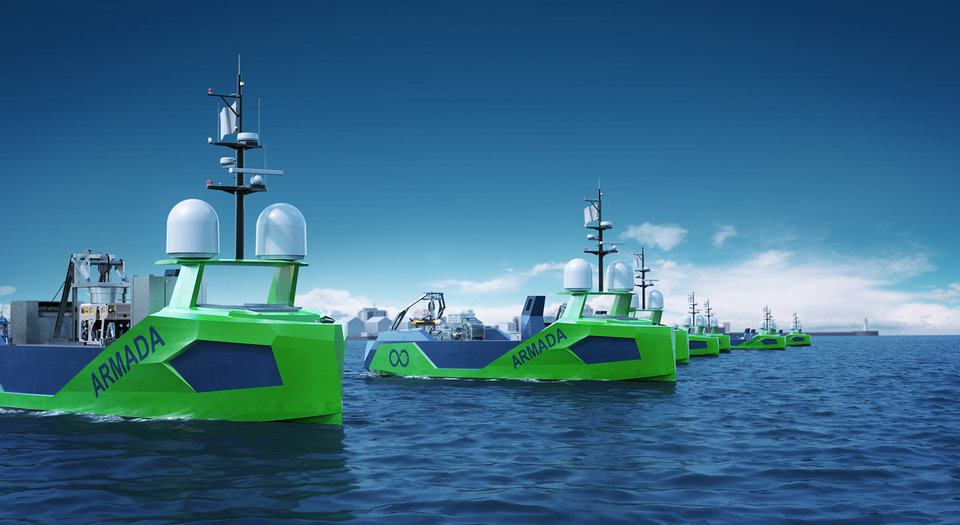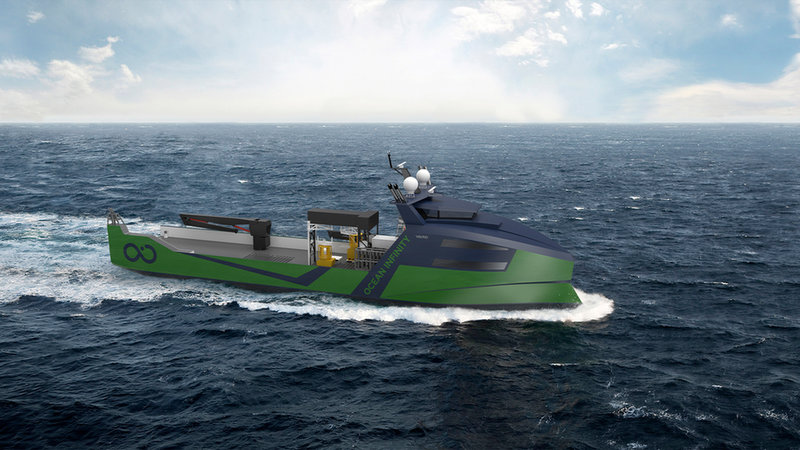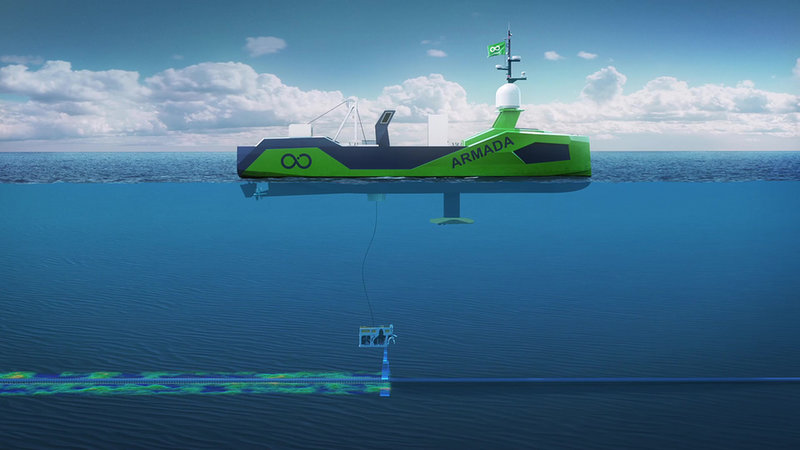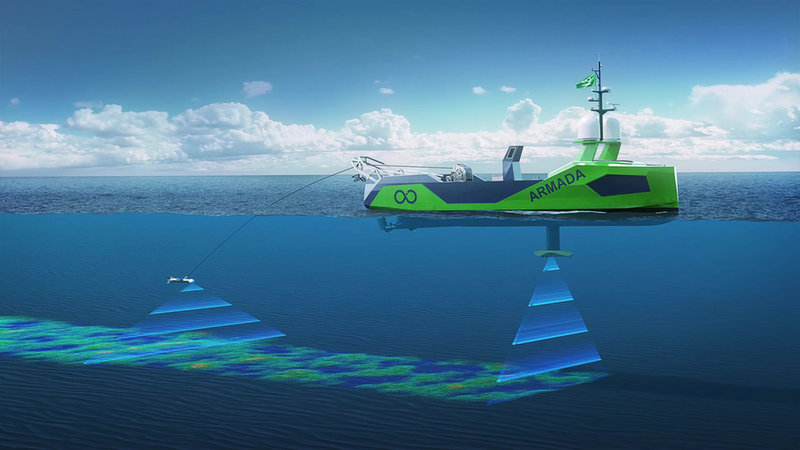
ROBOTICS
How innovation is changing the role of the seep hunter
Seep hunting is a costly process that doesn’t guarantee success, so knowing which seeps are most likely to result in a major discovery is key. Andrew Tunnicliffe talks with Ocean Infinity about how new technologies could reduce costs and improve the chances of success.
T
he history of oil and gas exploration is one that dates back a few hundred years, often coloured with tales of good fortune and incredible innovation. Few, though, fail to share one common theme: the discovery of a seep. On land or at sea, seeps have increasingly become the start of a field’s story.
Mapping the seabed for reserve potential is big business, and with that comes huge investment. It is no wonder that over the last 100 years or so the way it is done has changed. Technological advances render the sector of today unrecognisable to that of generations past.

Technology heralds the Armada
The next significant advance could be that ushered in with the announcement that global energy giant Shell was partnering with Ocean Infinity. The company, which has headquarters in the US and UK, specialises in marine robotics, with a growing focus on autonomy. Its latest offering, to be used as part of the collaboration, will be the ‘Armada’ fleet.
“The combination of Shell’s specialist seep hunting expertise and Ocean Infinity’s Armada fleet of robotic ships will provide effective location targeting and wide scale coverage,” explains Dan Hook, the company’s managing director. “In turn, this will culminate in more reliable results, improving the focus of exploration work.”
Announced in February 2020, Hook says that the fleet will be the world’s largest of low-emission, multi-role robotic ships, which will provide the “best quality data in the safest and most environmentally friendly manner”. Initially, the fleet will be made up of 21m and 36m vessels, the first of which is being built in the UK and should be fully operational later in 2021. Its biggest attraction is that it can be deployed worldwide and operated from land-based remote control centres.
Speaking at the time of the announcement, Ocean Infinity’s vice president for business development in oil and gas exploration services, Katya Krylova, said that the deployment of the Armada fleet “will mark a major technological advance in the industry and redefine traditional ways of working”.
The Armada fleet’s autonomous underwater vehicles offer deep-water coverage on a uniquely large scale
It is a view Hook supports, saying: “The Armada fleet’s autonomous underwater vehicles (AUVs) offer deep-water coverage on a uniquely large scale.”
The ability to operate these types of vessels remotely, or at the very least with a skeleton crew, will be hugely appealing to the sector, cutting the risks and costs of this essential process.
“With the Armada fleet, Ocean Infinity will be able to provide sustainable services to all corners of the industry. From survey to unexploded ordnance capability for the offshore wind market, [as well as] 2D and 3D seismic, oceanographic ,and metocean data acquisition and geotechnical capability,” Hook says.
The possibility of using AUVs remotely has been open for discussion for a while now and was presented in a paper at the 2018 Offshore Technology Conference in Texas. The author, Steffan Lindsø, proposed using technologies that had already been developed to address issues in subsea engineering, largely for installation and maintenance of offshore infrastructure.

The offshore sector heads more remote
Lindsø suggested that using the likes of multi-beam sonar, remotely operated vehicles (ROVs), autonomous pipeline inspection vehicle sensors, and satellite communication networks, combined with developments in sensing and analysing chemicals, could change the way that seep hunting is conducted.
He said: “Many of these new technologies can be combined into completely new ways of exploring for seepages to provide additional data to geologists and reduce the risk of drilling an unsuccessful exploratory well. The new method will be smarter, less expensive and capable of covering much larger areas of the seabed than current seep hunting techniques.”
Lindsø added that, most importantly, geologists will be able to stay onshore behind the ROVs pilot and explore the seabed in real-time.
The human expertise will be re-deployed onshore
The Armada fleet offers uncrewed and light-crewed operational capability at a scale that the industry has never seen before, according to the manufacturer. The company says that unlike smaller unmanned surface vehicles that can only deploy one type of sensor at a time, its vessels will be able to carry multiple sensors, as well as offer the option for additional modular payloads such as ROVs and AUVs.
Hook elaborates: “All vessels will be equipped with state-of-the-art sensors and pioneering navigational technology to ensure safe operations. The safety element is key – the fleet is considerably reducing the number of personnel required at sea. The human expertise will be re-deployed onshore.”
There is also a sustainability benefit to consider too, says Hook. “The fleet will use hybrid technology and will emit up to 90% less CO2 than a conventional survey vessel. Any remaining carbon emissions that are produced as a result of Armada operations will be sequestered via approved programmes. The Armada fleet will be the world’s first carbon-neutral shipping fleet.”

What future does remote autonomy have?
However, challenges lie ahead for this type of seep hunting operation. Being what Hook describes as a “relatively new” concept, there is work to do to define standards for safe operation. He says that work is ongoing with a number of different industry bodies and regulators with regards to working towards standards for safe operations of uncrewed vessels.
“Being the first company to take such a leap, deploying not only the largest robotics vessels out there but at a scale much larger than any other uncrewed fleet, we are taking our position of responsibility extremely seriously,” he adds.
Using UAVs to map the seabed isn’t something exclusive to Ocean Infinity. There are other significant players in the market, each developing their own technologies and growing their expertise.
Dutch multinational Furgo, for example, has been active in this field for decades, securing and carrying out an impressive array of contracts and developments. It uses its UAVs for a host of oil and gas activities; however there is growing interest in the potential for renewables. Today two-fifths of Furgo’s work comes from renewables.
We’re dedicated to creating more sustainable solutions in order to protect our oceans
For Ocean Infinity, the future of seep hunting is an exciting one, but sustainability is always at its core too. The Armada fleet – which will include eight additional 78m vessels by the end of 2022 – will support its commitment to do its part in reducing emissions.
“Environmental sustainability is at the heart of the business,” Hook continues. “We’re dedicated to creating more sustainable solutions in order to protect our oceans.”
Exploration is changing at pace, and will likely continue to in the coming months and years. Developments of this kind, however, have the potential to reshape it and other essential roles performed in the sector.
“Refining our ability to conduct tasks such as seep hunting using uncrewed technology opens up possibilities in so many other areas,” concluded Hook. “The experience gained as a result of this collaboration could prove transferable to other offshore tasks, such as carbon capture storage monitoring.”
All images credit: Ocean Infinity